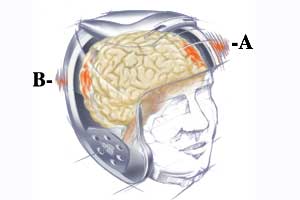Helmet Hunting

When it comes to comfort, all helmets are not equal. Just as different brands and styles of shoes are more suited to your foot shape, some helmets will fit your head better than others. “A helmet should fit like a baseball cap,” says Daryl Price of Giro Helmets. “It should be snug, but it shouldn’t have any pressure points.” Here are some tips from the Snell Memorial Foundation, a helmet-testing organization, to ensure a good fit.
1 Place the helmet level on your head, so that it sits low on your forehead. If you tilt your eyes upward, you should be able to see the edge of the helmet.
2 Adjust the chin-strap so that when buckled it holds the helmet firmly in place. Try to remove the helmet without undoing the chin-strap. If it comes off or shifts over your eyes, readjust and try again. You should not be able to move it more than an inch in any direction. If no adjustment seems to work, this helmet is not for you.
3 Test your strap adjustment each time you put on your helmet; otherwise it may not work when you need it to. It will also pay to be choosy in terms of design. Consider which features will be important to you¿for some, ventilation is key, while others are concerned about weight or goggle-compatibility. With any design, test its effect on your hearing and field of vision before you buy. After any big crash, it’s important to replace your helmet. Most helmets use a crushable liner made of expanded polystyrene (EPS), which can only handle one hard thump. Generally, the damage will be visible on the helmet. Some helmets use expanded polypropylene (EPP), which slowly rebounds after crushing, allowing it to take more than one small- to medium-sized hit. Its effectiveness does diminish with each impact, however, even if it appears undamaged, so the helmet should be replaced after several smaller crashes or one severe blow. Some companies offer to replace the helmet at a discounted price if you’ve been involved in a serious crash.
How It Works
DIAGRAM OF A BRAIN INJURY
The most common head injuries among skiers are impact injuries:
A Damage to the skull occurs at the point of impact.
B Often, the collision makes the brain bounce inside the skull, also causing damage to the part of the brain opposite the point of impact. Helmets can reduce the severity of impact on both sides of the brain.
ANATOMY OF A HELMET
A–Outer Plastic Shell Hard outer shell distributes the impact over the surface of the helmet. Also protects against penetration by sharp objects.
B–Liner Made of a crushable material that compresses to absorb impact and slow down the movement of the brain as it bounces after a collision.
C–Chin-Strap Keeps helmet in place.